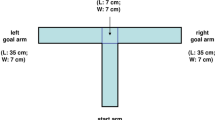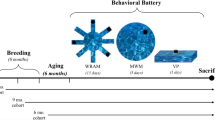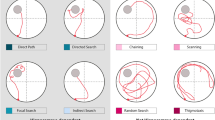Abstract
The radial arm water maze (RAWM) contains six swim paths (arms) extending out of an open central area, with an escape platform located at the end of one arm (the goal arm). The goal arm location remains constant for a given mouse. On day 1, mice are trained for 15 trials (spaced over 3 h), with trials alternating between visible and hidden platform. On day 2, mice are trained for 15 trials with the hidden platform. Entry into an incorrect arm is scored as an error. The RAWM has the spatial complexity and performance measurement simplicity of the dry radial arm maze combined with the rapid learning and strong motivation observed in the Morris water maze without requiring foot shock or food deprivation as motivating factors. With two sessions each day, 16 mice can be tested over 2 days.
This is a preview of subscription content, access via your institution
Access options
Subscribe to this journal
Receive 12 print issues and online access
$259.00 per year
only $21.58 per issue
Buy this article
- Purchase on Springer Link
- Instant access to full article PDF
Prices may be subject to local taxes which are calculated during checkout







Similar content being viewed by others
References
Hsiao, K. et al. Correlative memory deficits, Abeta elevation, and amyloid plaques in transgenic mice. Science 274, 99–102 (1996).
Holcomb, L.A. et al. Accelerated Alzheimer-type phenotype in transgenic mice carrying both mutant amyloid precursor protein and presenilin 1 transgenes. Nat. Med. 4, 97–100 (1998).
Janus, C. et al. Impaired conditioned taste aversion learning in APP transgenic mice. Neurobiol. Aging 25, 1213–1219 (2004).
Dodart, J.C. et al. Immunization reverses memory deficits without reducing brain Abeta burden in Alzheimer's disease model. Nat. Neurosci. 5, 452–457 (2002).
Morgan, D. et al. A beta peptide vaccination prevents memory loss in an animal model of Alzheimer's disease. Nature 408, 982–985 (2000).
Gordon, M.N. et al. Correlation between cognitive deficits and Aβ deposits in transgenic APP+PS1 mice. Neurobiol. Aging 22, 377–385 (2001).
Wilcock, D.M. et al. Passive immunotherapy against Abeta in aged APP-transgenic mice reverses cognitive deficits and depletes parenchymal amyloid deposits in spite of increased vascular amyloid and microhemorrhage. J. Neuroinflamm. 1, 24 (2004).
Wilcock, D.M. et al. Deglycosylated anti-amyloid-beta antibodies eliminate cognitive deficits and reduce parenchymal amyloid with minimal vascular consequences in aged amyloid precursor protein transgenic mice. J. Neurosci. 26, 5340–5346 (2006).
Diamond, D.M., Park, C.R., Heman, K.L. & Rose, G.M. Exposing rats to a predator impairs spatial working memory in the radial arm water maze. Hippocampus 9, 542–551 (1999).
Bimonte, H.A. & Denenberg, V.H. Estradiol facilitates performance as working memory load increases. Psychoneuroendocrinology 24, 161–173 (1999).
Chang, B. et al. Retinal degeneration mutants in the mouse. Vis. Res. 42, 517–525 (2002).
Clapcote, S.J., Lazar, N.L., Bechard, A.R., Wood, G.A. & Roder, J.C. NIH Swiss and Black Swiss mice have retinal degeneration and performance deficits in cognitive tests. Comp. Med. 55, 310–316 (2005).
Lewis, J. et al. Neurofibrillary tangles, amyotrophy and progressive motor disturbance in mice expressing mutant (P301L) tau protein. Nat. Genet. 25, 402–405 (2000).
Acknowledgements
We have been supported by NIH awards AG15490, AG18478, AG25509, AG25711 and NS48335. D.W. was a Benjamin Scholar in Alzheimer's Research.
Author information
Authors and Affiliations
Corresponding author
Ethics declarations
Competing interests
The authors declare no competing financial interests.
Supplementary information
Rights and permissions
About this article
Cite this article
Alamed, J., Wilcock, D., Diamond, D. et al. Two-day radial-arm water maze learning and memory task; robust resolution of amyloid-related memory deficits in transgenic mice. Nat Protoc 1, 1671–1679 (2006). https://doi.org/10.1038/nprot.2006.275
Published:
Issue Date:
DOI: https://doi.org/10.1038/nprot.2006.275
This article is cited by
-
Neonatal loss of FGFR2 in astroglial cells affects locomotion, sociability, working memory, and glia-neuron interactions in mice
Translational Psychiatry (2023)
-
Combined space stressors induce independent behavioral deficits predicted by early peripheral blood monocytes
Scientific Reports (2023)
-
Semaphorin 4D is upregulated in neurons of diseased brains and triggers astrocyte reactivity
Journal of Neuroinflammation (2022)
-
Targeted Tshz3 deletion in corticostriatal circuit components segregates core autistic behaviors
Translational Psychiatry (2022)
-
Accumulation of C-terminal cleaved tau is distinctly associated with cognitive deficits, synaptic plasticity impairment, and neurodegeneration in aged mice
GeroScience (2022)
Comments
By submitting a comment you agree to abide by our Terms and Community Guidelines. If you find something abusive or that does not comply with our terms or guidelines please flag it as inappropriate.



